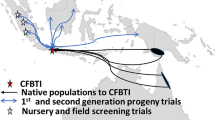Abstract
Ten F2 clones from an initial hybridization of Prunus webbii × Prunus persica cv Harrow Blood were evaluated under greenhouse conditions for their reaction to Xylella fastidiosa subsp. fastidiosa strain M23 during two growing seasons. Clonal accessions used for the study were selected on the basis of horticultural diversity, and were a small subset of trees from a large F2 population. Foliar symptoms of M23-inoculated trees were monitored weekly throughout the 20-week growth period. Clones were then sampled for bacterial titer determinations. With the exception of parental accession Harrow Blood, all clones yielded measurable titer; however, almond leaf scorch disease symptoms were never observed in five of the ten sibling clonal accessions. Vegetative bud break and bloom phenology data collected from field-grown mother trees over a 7 year period as well as leaf morphology characters of the clonal accessions were examined for associations with bacterial titers of inoculated clones using a principal components analysis. No clear associations were noted, with small sample size limiting the predictive ability of the analysis.

Similar content being viewed by others
References
Baninasab B, Rahemi M (2007) Evaluation of three wild species of almond on the basis of their morphological characters. J Cent Eur Agric 7:619–626
Baumgartner K, Fujiyoshi P, Ledbetter C, Duncan R, Kluepfel D (2018) Screening almond rootstocks for sources of resistance to Armillaria root disease. HortScience 53(1):4–8
Bent E, Loffredo A, Yang J, McKenry MV, Becker JO, Borneman J (2009) Investigations into peach seedling stunting caused by a replant soil. FEMS Microbiol Ecol 68(2):192–200
Bliss FA, Arulsekar S, Foolad MR, Becerra V, Gillen AM, Warburton ML, Dandekar AM, Kocsisne GM, Mydin KK (2002) An expanded genetic linkage map of Prunus based on an interspecific cross between almond and peach. Genome 45:520–529
Bliss FA, Almehdi AA, Dejong TM, Gillen AM, Ledbetter CA (2011) Peach rootstock cv. HBOK 50. United States Patent and Trademark Office, PP22,208
Bliss FA, Almehdi AA, Dejong TM, Gillen AM, Ledbetter CA (2012a) Peach rootstock cv. HBOK 10. United States Patent and Trademark Office, PP22,505
Bliss FA, Almehdi AA, Dejong TM, Gillen AM, Ledbetter CA (2012b) Peach rootstock cv. HBOK 32. United States Patent and Trademark Office, PP22,845
Bliss FA, Almehdi AA, Dejong TM, Ledbetter CA (2013) Peach rootstock cv. HBOK 27. United States Patent and Trademark Office, PP23,631
Boonprakob U, Byrne DH, Mueller DMJ (1996) Anatomical differences of axillary bud development in blind nodes and normal nodes in peach. HortScience 31(5):798–801
Browne G, Grant J, Schmidt L, Leslie C, McGranahan G (2011) Resistance to Phytophthora and graft compatibility with Persian walnut among seedlings of Chinese wingnut from different sources. HortScience 46:371–376
Cao T, Connell JH, Wilhelm M, Kirkpatrick BC (2011) Influence of inoculation date on the colonization of Xylella fastidiosa and the persistence of almond leaf scorch disease among almond cultivars. Plant Dis 95:158–165
Chen J, Groves R, Civerolo EL, Viveros M, Freeman M, Zheng Y (2005) Two Xylella fastidiosa genotypes associated with almond leaf scorch disease on the same location in California. Phytopathology 95:708–714
Davis MJ, Purcell AH, Thomson SV (1980) Isolation media for Pierce’s disease bacterium. Phytopathology 70:425–429
Griffin D, Anchukaitis KJ (2014) How unusual is the 2012–2014 California drought? Geophys Res Lett 41:9017–9023
Gülcan R (1985) Descriptor list for almond (Prunus amygdalus). (Revised edition). International Board for Plant Genetic Resources, Rome
Hajjar R, Hodgkin T (2007) The use of wild relatives in crop improvement: a survey of developments over the last 20 years. Euphytica 156:1–13
Kluepfel DA, McClean AE, Aradhya MK, Moersfelder JW (2015) Identification of Juglans wild relatives resistant to crown gall caused by Agrobacterium tumefaciens. Acta Hortic 1074:87–94
Krugner R, Ledbetter CA (2016) Rootstock effects on almond leaf scorch disease incidence and severity. Plant Dis 100(8):1617–1621
Ledbetter CA, Rogers EE (2009) Differential susceptibility of Prunus germplasm (Subgenus Amygdalus) to a California isolate of Xylella fastidiosa. HortScience 44(7):1928–1931
Ledbetter CA, Sisterson MS (2008) Advanced generation peach-almond hybrids as seedling rootstocks for almond: first year growth and potential pollinizers for hybrid seed production. Euphytica 160(2):259–266
Rogers EE, Ledbetter CA (2015) Susceptibility to Xylella fastidiosa in a first-generation hybrid from a non-traditional peach-almond cross. HortScience 50(3):337–340
Sisterson MS, Ledbetter CA, Chen J, Higbee BS, Groves RL, Daane KM (2012) Management of almond leaf scorch disease: long-term data on yield, tree vitality and disease progress. Plant Dis 96:1037–1044
Weinberger JH (1959) Notice to nurserymen on a new nematode resistant peach rootstock. USDA/Agricultural Research Service variety release notice
Wells J, Raju B, Hung HY, Weisburg W, Mandelco-Paul L, Brenner D (1987) Xylella fastidiosa gen. nov., sp. nov: gram-negative, xylem-limited, fastidious plant bacteria related to Xanthomonas campestris. Int J Syst Bacteriol 37:136–143
Zasada IA, Halbrendt JM, Kokalis-Burelle N, LaMondia J, McKenry MV, Noling JW (2010) Managing nematodes without methyl bromide. Ann Rev Phytopath 48:311–328
Acknowledgements
The authors would like to acknowledge anonymous Reviewer 1 for their committed efforts in improving this manuscript. We gratefully acknowledge Biological Technician Page Johnston for collection of leaf morphology data from mother trees as well as for dedicated care of trialed clones during the two growing seasons. Mention of trade names or commercial products in this publication is solely for the purpose of providing specific information and does not imply recommendation or endorsement by the U.S. Department of Agriculture. USDA is an equal opportunity provider and employer.
Author information
Authors and Affiliations
Corresponding author
Rights and permissions
About this article
Cite this article
Ledbetter, C.A., Lee, S. Diversity of Xylella fastidiosa host suitability among siblings from a non-traditional interspecific Prunus cross. Euphytica 214, 84 (2018). https://doi.org/10.1007/s10681-018-2167-6
Received:
Accepted:
Published:
DOI: https://doi.org/10.1007/s10681-018-2167-6




